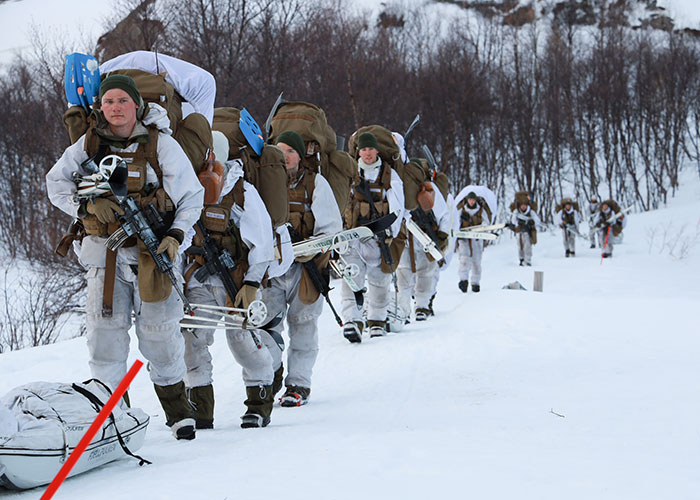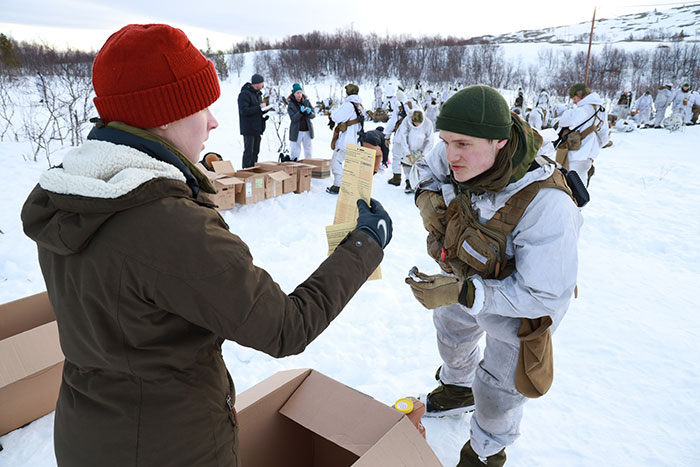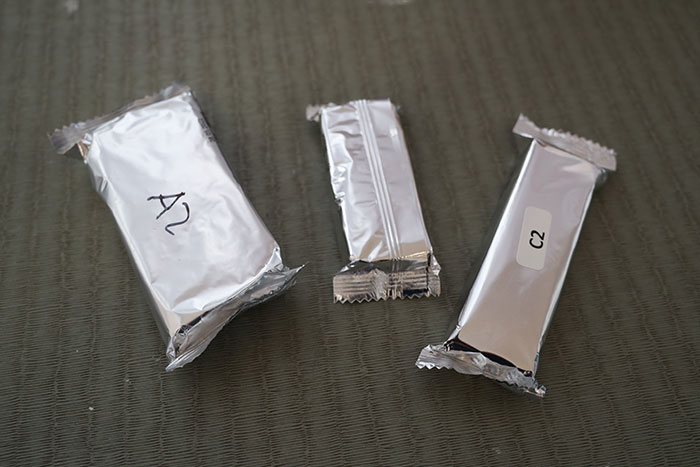Fueling Soldier Performance in The Frozen Frontier

The Arctic Circle–an environment notable for volatile conditions like blizzards, shifting ice, variable terrain, and extreme cold–can be a harsh setting for people to endure, but a necessary one for Warfighters to train in.
With an increase in threat-level from foreign adversaries from cold climate zones, Soldiers are working to improve their readiness–the ability to perform all duties in any place–in cold conditions. Whether a Soldier is in a hot or cold setting, the environment can have a significant influence on warfare success. Appropriately managing nutrition in these environments is critical to maintaining Soldier readiness.
"The human body adapts to austere environments, which can affect health and military performance. As a whole, the Army has an interest in helping Soldiers prepare for the cold." said Dr. James McClung, Chief of the Military Nutrition Division (MND) at the U.S. Army Research Institute of Environmental Medicine (USARIEM). "Our responsibility is to better understand the physiological nutrition requirements of Warfighters, which may be different from the civilian public."
Cold climates can amplify an individual's risk to cold-related injuries like hypothermia, frostbite and even require the body to use more energy to stay warm. Soldiers experience this too, but with added risks from intense combat operations that require their bodies to burn up to 6,000 calories a day.
As they burn twice as much as what they eat, a Soldier may enter a calorie deficit that results in muscle loss, which may affect mobility and strength. If mobility and strength are negatively affected, a Warfighter's readiness may also be directly impacted.
To gain a better understanding of nutrition requirements during cold-weather military operations, Physiologist Dr. Stefan Pasiakos, Chief of the Military Performance Division at USARIEM, joined forces with the Norwegian Defense Research Establishment (FFI) a decade ago to collaborate on an American-Norwegian research project.
Within the collaboration, a series of studies investigating performance and nutrition requirements during cold-weather operations were conducted in 2013 and 2015, and recently a third study was added to the list.
Unraveling A New Unknown

Bundled in Norwegian parkas with a frosty sheen, Dr. Emily Howard, Nutrition Physiologist for MND, and a team of researchers from USARIEM and FFI returned to the Garrison of Sør-Varanger in Kirkenes, Norway, in March 2022 for a new study examining two potential nutrition-based interventions during arctic military training.
This most recent investigation was built on findings from the two previous studies conducted by Dr. Lee Margolis, Nutrition Physiologist for MND at USARIEM, and Pasiakos.
"In the first study, our team went out to observe a seven-day military operation by collecting ration trash and measure how many calories are being burned," said Margolis. "After finding out Soldiers burn 6,000 calories and only consume 3,000 calories, we did a second study to minimize those negative effects by providing an extra 1,000 calories."
Military training in cold environments can affect a Warfighter's energy expenditure–total energy required to maintain the essential body functions. If energy expenditure is higher than food intake, then a Soldier will enter a negative energy balance or calorie deficit. When these periods of calorie deficit are long, they result in consequences such as muscle loss, which can interfere with Soldier readiness.
"Service Members may exhibit a loss in weight, have limited fuel availability, and have a decline in physical performance," said Margolis. "The more severe the calorie deficit is, the greater the decline in performance. As we saw in the initial studies, it can ultimately impact a Service Member's readiness."
Findings from the initial studies suggested that a calorie deficit is manageable when it is less than 40% of calorie requirements, which may result in smaller impacts to a Soldier's readiness.
"We want them to eat enough calories on a daily basis to achieve an acceptable negative energy balance," Margolis said.
This is what led to Howard's testing of other nutrition-based interventions during arctic training.
Participants in the most recent study were Norwegian Soldiers that were randomly assigned to consume one of three supplemental bars during an 8-day arctic training exercise: a high-fat energy dense bar, an essential amino acid-enriched bar, or a high carbohydrate bar as a control.
"The essential amino acid bar was the product of a series of laboratory-based studies conducted at USARIEM by Dr. Jess Gwin in collaboration with the University of Arkansas for Medical Sciences to determine the optimal essential amino acid content and delivery format for a protein-based recovery ration product," said Howard. "Consuming greater amounts of essential amino acids during periods of unavoidable energy deficit may prevent muscle breakdown and promote muscle repair."
The energy dense bar was created based on what Howard and her team believed would increase energy intake during cold-weather operations.
"The previous studies showed us that there may be a limit to the volume of food Soldiers were willing and able to consume. Increasing energy density by providing the same calories in a smaller volume of food may be one strategy for promoting energy intake," Howard said.
Ultimately, the nutrition interventions did not affect calorie intake, calorie deficit, or the retention of body protein during the training exercise. "These findings were consistent with our previous work and tell us that macronutrient content of the diet does not spare body protein when total energy intake is high enough to limit energy deficits to moderate levels."
Working towards Innovation

Behind a Soldier's body and fastened on their shoulders are large rucksacks filled with ammunition, tools, first aid kits, a sleeping bag, flashlights, tactical gear and hydration bladders that can easily become as heavy as 105 pounds.
Since these rucksacks can quickly reach capacity and be hefty, increasing the amount Soldiers eat while utilizing the limited space in their rucksacks can be difficult. However, providing energy dense foods like those tested in this series of studies may be a way to provide enough calories for Warfighters while also taking up less space.
Currently using this research, the Combat Feeding Division at DEVCOM-SC is working on a next generation ration food product for Soldiers. Varying weather, altitudes and intensity of work demand are factors shared with combat feeding to determine what goes into a military ration.
McClung says that investigating a Soldier's nutrition can aid understanding to propose alternatives to maintaining performance in the field and decreasing injury.
"Our researchers continuously strive to improve the readiness of Soldiers and in this case, improving cognitive and physical performance in an Arctic environment," Margolis said. "This ongoing American-Norwegian research collaboration has allowed us to investigate nutrition and its impact on performance so that we can see the weaknesses we have in our current system and make it a strength to benefit Warfighters."
USARIEM is a subordinate command of the U.S. Army Medical Research and Development Command under the Army Futures Command. USARIEM is internationally recognized as the DOD's premier laboratory for Warfighter health and performance research and focuses on environmental medicine, physiology, physical and cognitive performance, and nutrition research. Located at the Natick Soldier Systems Center in Natick, Massachusetts, USARIEM's mission is to optimize Warfighter health and performance through biomedical research.













